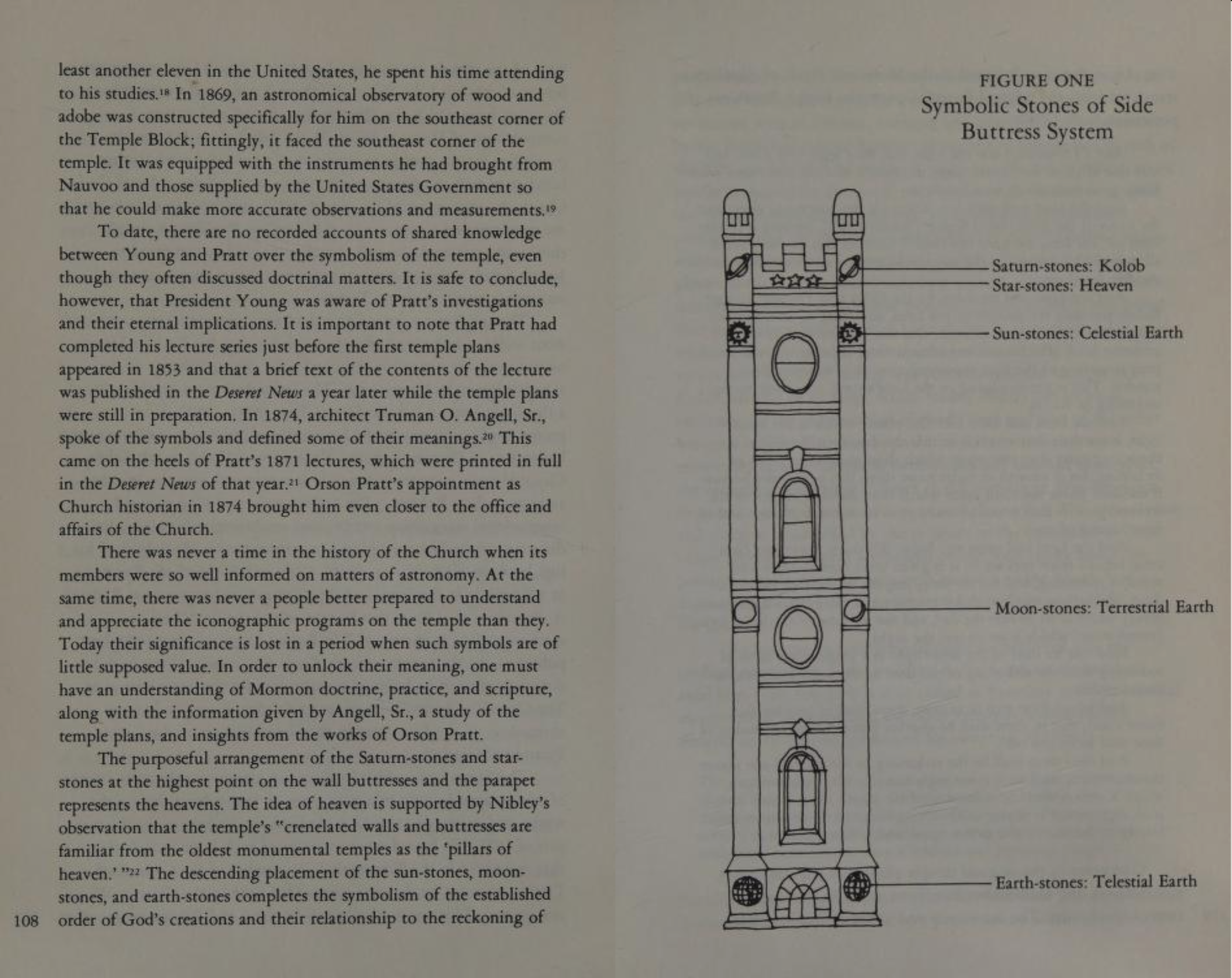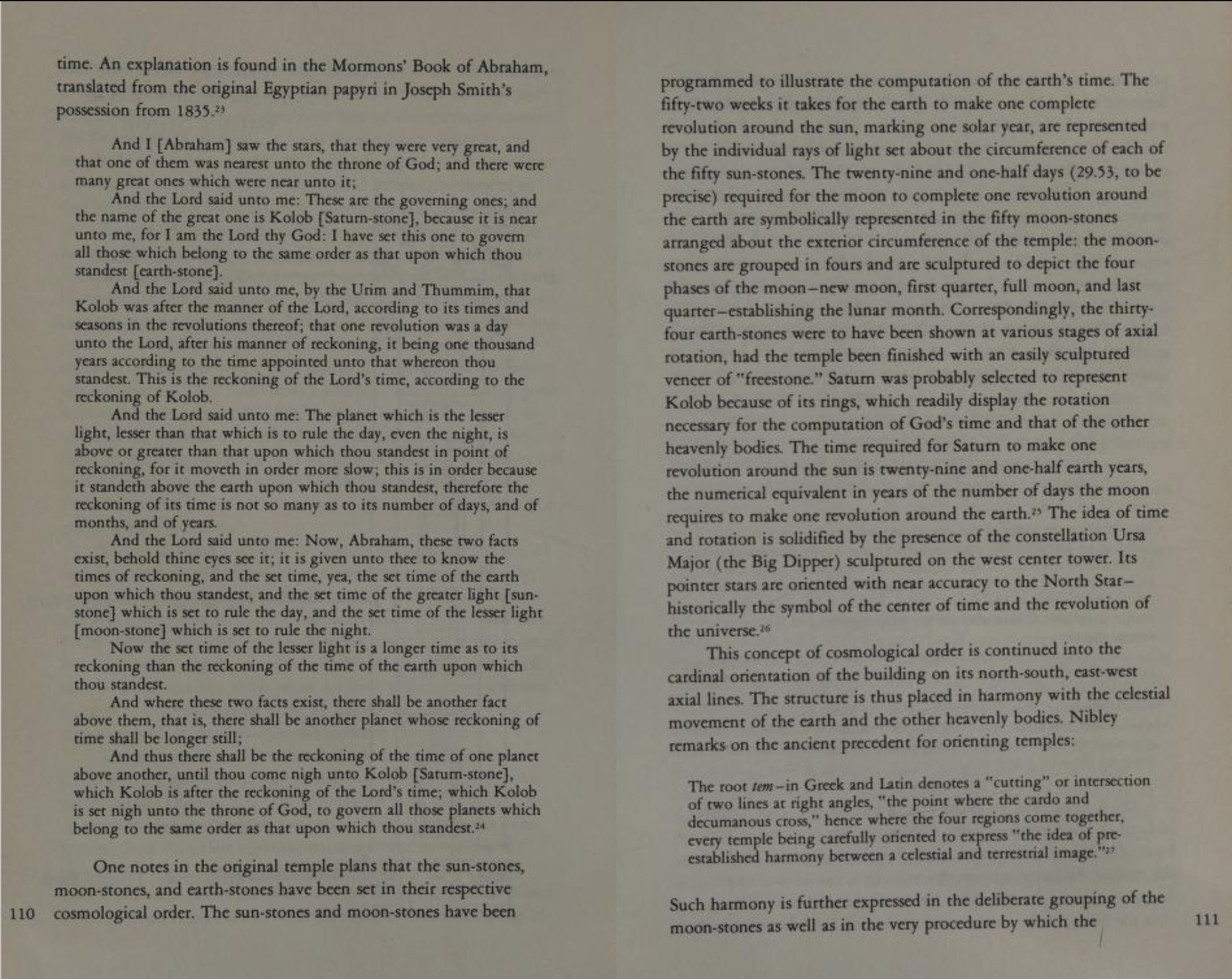CMH connects Kolob and cites BOA with astronomical symbolism on the Salt Lake Temple.
- Type
- Book
- Source
- C. Mark Hamilton LDS
- Hearsay
- Direct
- Reference
C. Mark Hamilton, "The Salt Lake Temple: A Symbolic Statement of Mormon Doctrine," in Thomas G. Alexander, ed., The Mormon People: Their Character and Traditions (Provo: Brigham Young University Press, 1980), 108–111
- Scribe/Publisher
- Brigham Young University Press
- Audience
- Reading Public
- Transcription
There was never a time in the history of the Church when its members were so well informed on matters of astronomy. At the same time, there was never a people better prepared to understand and appreciate the iconographic programs on the temple than they. Today their significance is lost in a period when such symbols are of little supposed value. In order to unlock their meaning, one must have an understanding of Mormon doctrine, practice, and scripture, along with the information given by [Truman O.] Angell, Sr., a study of the temple plans, and insights from the works of Orson Pratt.
The purposeful arrangement of the Saturn-stones and star-stones at the highest point on the wall buttresses the parapet represents the heavens. The idea of heaven is supported by [Hugh] Nibley's observation that the temple's "crenelated walls and buttresses are familiar from the oldest monumental temples as the 'pillars of heaven.'" The descending placement of the sun-stones, moon-stones, and earth-stones completes the symbolism of the established order of God's creations and their relationship to the reckoning of time. An explanation is found in the Mormons' Book of Abraham, translated from the original Egyptian papyri in Joseph Smith's possession from 1835.
And I [Abraham] saw the stars, that they were very great, and that one of them was nearest unto the throne of God; and there were many great ones which were near unto it;
And the Lord said unto me: These are the governing ones; and the name of the great one is Kolob [Saturn-stone], because it is near unto me, for I am the Lord thy God: I have set this one to govern all those which belong to the same order as that upon which thou standest [earth-stone].
And the Lord said unto me, by the Urim and Thummim, that Kolob was after the manner of the Lord, according to its times and seasons in the revolutions thereof; that one revolution was a day unto the Lord, after his manner of reckoning, it being one thousand years according to the time appointed unto that whereon thou standest. This is the reckoning of the Lord’s time, according to the reckoning of Kolob.
And the Lord said unto me: The planet which is the lesser light, lesser than that which is to rule the day, even the night, is above or greater than that upon which thou standest in point of reckoning, for it moveth in order more slow; this is in order because it standeth above the earth upon which thou standest, therefore the reckoning of its time is not so many as to its number of days, and of months, and of years.
And the Lord said unto me: Now, Abraham, these two facts exist, behold thine eyes see it; it is given unto thee to know the times of reckoning, and the set time, yea, the set time of the earth upon which thou standest, and the set time of the greater light [sun-stone] which is set to rule the day, and the set time of the lesser light [moon-sonte] which is set to rule the night.
Now the set time of the lesser light is a longer time as to its reckoning than the reckoning of the time of the earth upon which thou standest.
And where these two facts exist, there shall be another fact above them, that is, there shall be another planet whose reckoning of time shall be longer still;
And thus there shall be the reckoning of the time of one planet above another, until thou come nigh unto Kolob [Saturn-stone], which Kolob is after the reckoning of the Lord’s time; which Kolob is set nigh unto the throne of God, to govern all those planets which belong to the same order as that upon which thou standest.
One notes in the original temple plans that the sun-stones, moon-stones, and earth-stones have been set in their respective cosmological order. The sun-stones and moon-stones have been programmed to illustrate the computation of the earth's time. The fifty-two weeks it takes for the earth to make one complete revolution around the sun, marking on solar year, are represented by the individual rays of light set about the circumference of each of the fifty sun-stones. The twenty-nine and one-half days (29.53, to be precise) required for the moon to complete one revolution around the earth are symbolically represented in the fifty moon-stones arranged about the exterior circumference of the temple: the moon-stones are grouped in fours and are sculpted to depict the four phases of the moon—new moon, first quarter, full moon, and last quarter—establishing the lunar month. Correspondingly, the thirty-four earth-stones were to have been shown at various stages of axial rotation, had the temple been finished with an easily sculpted veneer of "freestone." Saturn was probably selected to represent Kolob because of its rings, which readily display the rotation necessary for the computation of God's time and that of the other heavenly bodies. The time required for Saturn to make one revolution around the sun is twenty-nine and one-half earth years, the numerical equivalent in years of the number of days the moon requires to make one revolution around the earth. The idea of time and rotation is solidified by the presence of the constellation Ursa Major (the Big Dipper) sculptured on the west center tower. Its pointer stars are oriented with near accuracy to the North Star—historically the symbol of the center of time and the revolution of the universe.
- Citations in Mormonr Qnas
The B. H. Roberts Foundation is not owned by, operated by, or affiliated with the Church of Jesus Christ of Latter-day Saints.


